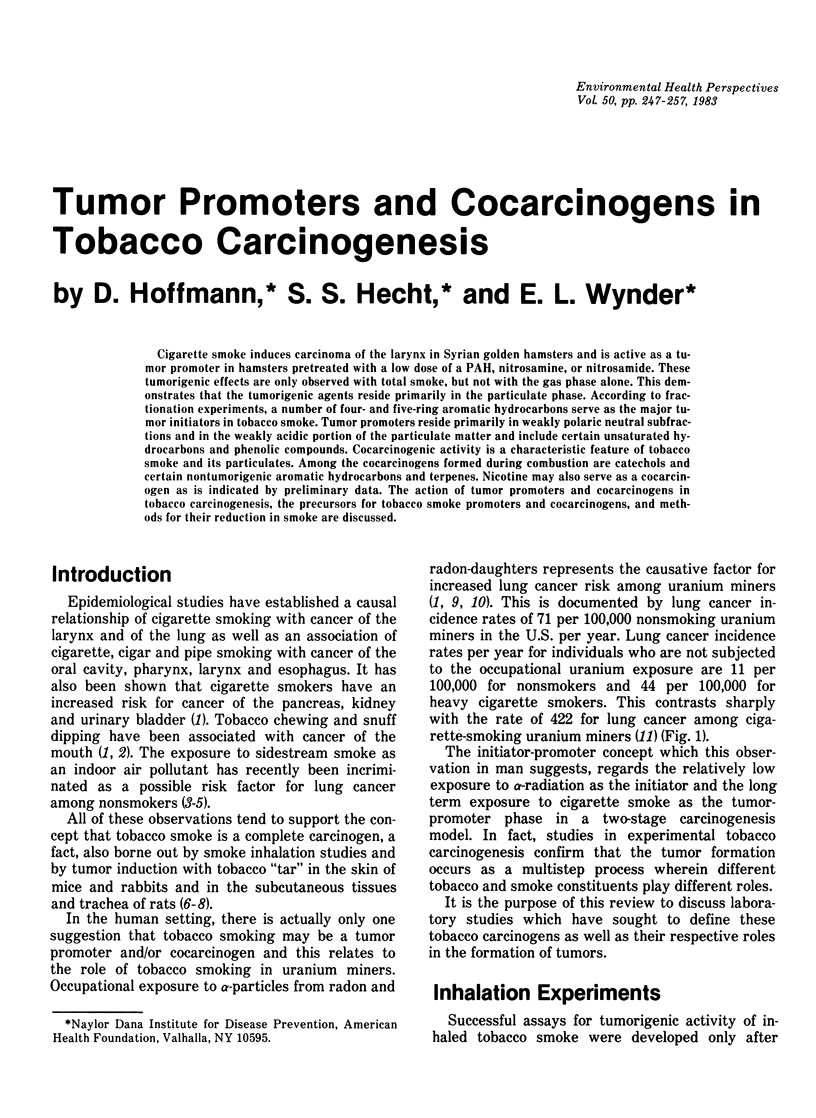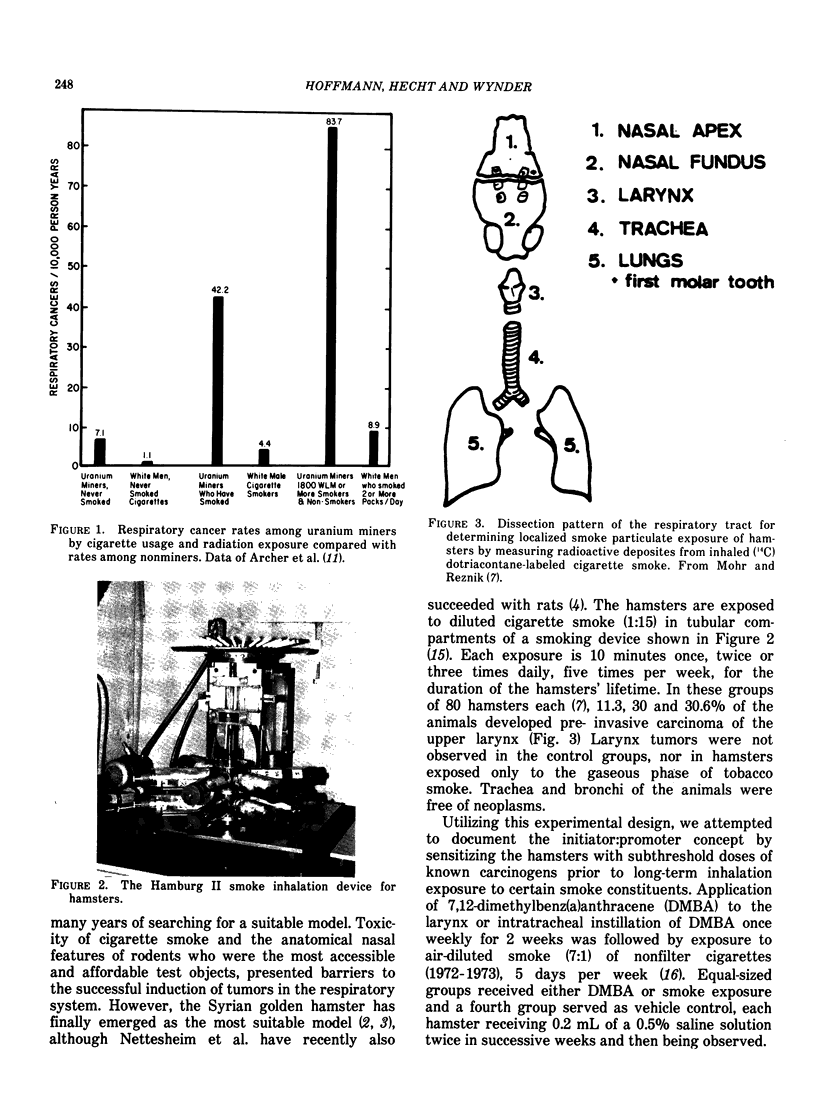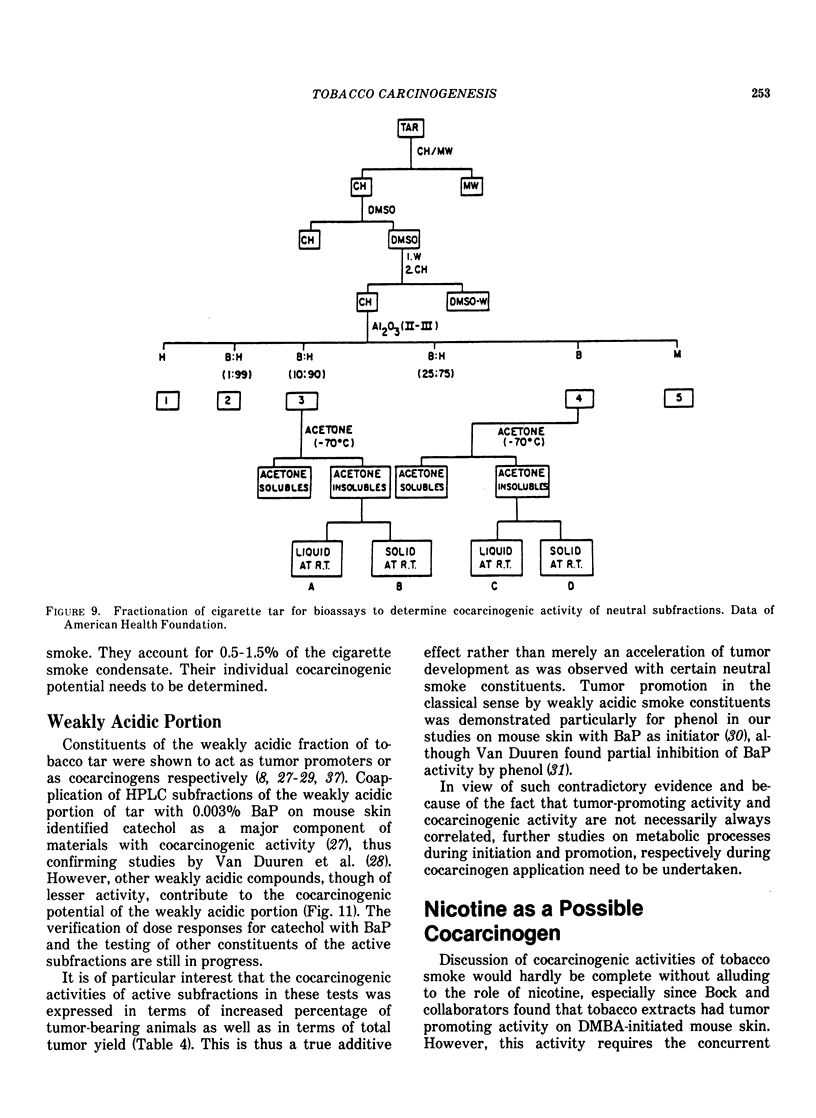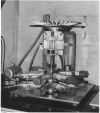Abstract
Cigarette smoke induces carcinoma of the larynx in Syrian golden hamsters and is active as a tumor promoter in hamsters pretreated with a low dose of a PAH, nitrosamine, or nitrosamide. These tumorigenic effects are only observed with total smoke, but not with the gas phase alone. This demonstrates that the tumorigenic agents reside primarily in the particulate phase. According to fractionation experiments, a number of four- and five-ring aromatic hydrocarbons serve as the major tumor initiators in tobacco smoke. Tumor promoters reside primarily in weakly polaric neutral subfractions and in the weakly acidic portion of the particulate matter and include certain unsaturated hydrocarbons and phenolic compounds. Cocarcinogenic activity is a characteristic feature of tobacco smoke and its particulates. Among the cocarcinogens formed during combustion are catechols and certain nontumorigenic aromatic hydrocarbons and terpenes. Nicotine may also serve as a cocarcinogen as is indicated by preliminary data. The action of tumor promoters and cocarcinogens in tobacco carcinogenesis, the precursors for tobacco smoke promoters and cocarcinogens, and methods for their reduction in smoke are discussed.
Full text
PDF










Images in this article
Selected References
These references are in PubMed. This may not be the complete list of references from this article.
- Archer V. E., Wagoner J. K., Lundin F. E., Jr Uranium mining and cigarette smoking effects on man. J Occup Med. 1973 Mar;15(3):204–211. [PubMed] [Google Scholar]
- Bernfeld P., Homburger F., Soto E., Pai K. J. Cigarette smoke inhalation studies in inbred Syrian golden hamsters. J Natl Cancer Inst. 1979 Sep;63(3):675–689. doi: 10.1093/jnci/63.3.675. [DOI] [PubMed] [Google Scholar]
- Dalbey W. E., Nettesheim P., Griesemer R., Caton J. E., Guerin M. R. Chronic inhalation of cigarette smoke by F344 rats. J Natl Cancer Inst. 1980 Feb;64(2):383–390. doi: 10.1093/jnci/64.2.383. [DOI] [PubMed] [Google Scholar]
- Donaldson A. W. The epidemiology of lung cancer among uranium miners. Health Phys. 1969 May;16(5):563–569. doi: 10.1097/00004032-196905000-00003. [DOI] [PubMed] [Google Scholar]
- Dontenwill W., Chevalier H. J., Harke H. P., Lafrenz U., Reckzeh G., Schneider B. Investigations on the effects of chronic cigarette-smoke inhalation in Syrian golden hamsters. J Natl Cancer Inst. 1973 Dec;51(6):1781–1832. doi: 10.1093/jnci/51.6.1781. [DOI] [PubMed] [Google Scholar]
- HOFFMANN D., WYNDER E. L. STUDIES ON GASOLINE ENGINE EXHAUST. J Air Pollut Control Assoc. 1963 Jul;13:322–327. doi: 10.1080/00022470.1963.10468184. [DOI] [PubMed] [Google Scholar]
- Hecht S. S., Carmella S., Mori H., Hoffmann D. A study of tobacco carcinogenesis. XX. Role of catechol as a major cocarcinogen in the weakly acidic fraction of smoke condensate. J Natl Cancer Inst. 1981 Jan;66(1):163–169. [PubMed] [Google Scholar]
- Hirayama T. Non-smoking wives of heavy smokers have a higher risk of lung cancer: a study from Japan. Br Med J (Clin Res Ed) 1981 Jan 17;282(6259):183–185. doi: 10.1136/bmj.282.6259.183. [DOI] [PMC free article] [PubMed] [Google Scholar]
- Hoffmann D., Castonguay A., Rivenson A., Hecht S. S. Comparative carcinogenicity and metabolism of 4-(methylnitrosamino)-1-(3-pyridyl)-1-butanone and N'-nitrosonornicotine in Syrian golden hamsters. Cancer Res. 1981 Jun;41(6):2386–2393. [PubMed] [Google Scholar]
- Hoffmann D., Rivenson A., Hecht S. S., Hilfrich J., Kobayashi N., Wynder E. L. Model studies in tobacco carcinogenesis with the Syrian golden hamster. Prog Exp Tumor Res. 1979;24:370–390. doi: 10.1159/000402112. [DOI] [PubMed] [Google Scholar]
- Hoffmann D., Wynder E. L. A study of tobacco carcinogenesis. XI. Tumor initiators, tumor accelerators, and tumor promoting activity of condensate fractions. Cancer. 1971 Apr;27(4):848–864. doi: 10.1002/1097-0142(197104)27:4<848::aid-cncr2820270415>3.0.co;2-4. [DOI] [PubMed] [Google Scholar]
- Hoffmann D., Wynder E. L. Smoking and occupational cancers. Prev Med. 1976 Jun;5(2):245–261. doi: 10.1016/0091-7435(76)90043-8. [DOI] [PubMed] [Google Scholar]
- Kobayashi N., Hoffmann D., Wynder E. L. A study of tobacco carcinogenesis. XII. Epithelial changes induced in the upper respiratory tracts of Syrian golden hamsters by cigarette smoke. J Natl Cancer Inst. 1974 Oct;53(4):1085–1089. doi: 10.1093/jnci/53.4.1085. [DOI] [PubMed] [Google Scholar]
- Van Duuren B. L., Goldschmidt B. M. Cocarcinogenic and tumor-promoting agents in tobacco carcinogenesis. J Natl Cancer Inst. 1976 Jun;56(6):1237–1242. doi: 10.1093/jnci/56.6.1237. [DOI] [PubMed] [Google Scholar]
- Van Duuren B. L., Katz C., Goldschmidt B. M. Cocarcinogenic agents in tobacco carcinogenesis. J Natl Cancer Inst. 1973 Aug;51(2):703–705. [PubMed] [Google Scholar]
- WYNDER E. L., HOFFMANN D. A study of tobacco carcinogenesis. VIII. The role of the acidic fractions as promoters. Cancer. 1961 Nov-Dec;14:1306–1315. doi: 10.1002/1097-0142(196111/12)14:6<1306::aid-cncr2820140621>3.0.co;2-t. [DOI] [PubMed] [Google Scholar]
- Wehner A. P., Busch R. H., Olson R. J., Craig D. K. Chronic inhalation of asbestos and cigarette smoke by hamsters. Environ Res. 1975 Dec;10(3):368–383. doi: 10.1016/0013-9351(75)90032-8. [DOI] [PubMed] [Google Scholar]
- Wehner A. P., Busch R. H., Olson R. J. Effects of diethylnitrosamine and cigarette smoke on hamsters. J Natl Cancer Inst. 1976 Apr;56(4):749–756. doi: 10.1093/jnci/56.4.749. [DOI] [PubMed] [Google Scholar]
- Winn D. M., Blot W. J., Shy C. M., Pickle L. W., Toledo A., Fraumeni J. F., Jr Snuff dipping and oral cancer among women in the southern United States. N Engl J Med. 1981 Mar 26;304(13):745–749. doi: 10.1056/NEJM198103263041301. [DOI] [PubMed] [Google Scholar]
- Wynder E. L., Hoffmann D. A study of tobacco carcinogenesis. X. Tumor promoting activity. Cancer. 1969 Aug;24(2):289–301. doi: 10.1002/1097-0142(196908)24:2<289::aid-cncr2820240212>3.0.co;2-8. [DOI] [PubMed] [Google Scholar]
- Wynder E. L., Stellman S. D. Comparative epidemiology of tobacco-related cancers. Cancer Res. 1977 Dec;37(12):4608–4622. [PubMed] [Google Scholar]
- Wynder E. L. Tumor enhancers: underestimated factors in the epidemiology of lifestyle-associated cancers. Environ Health Perspect. 1983 Apr;50:15–21. doi: 10.1289/ehp.835015. [DOI] [PMC free article] [PubMed] [Google Scholar]




